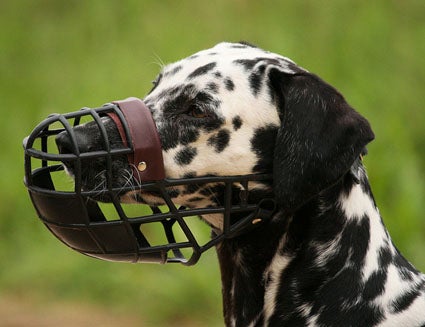When and Why Your Dog May Need to Wear a Muzzle

If you are walking down the street and you come upon a person walking a dog wearing a muzzle, your first instinct may be to cross the street or to at least give the pair a little extra room. A dog wearing a muzzle often incites fear and anxiety or, at the very least, a mild concern that the dog might be aggressive or dangerous. While this may be true in some cases, there are plenty of reasons why a dog owner might place his gentle, harmless dog in a muzzle. Keep reading to learn when and why you might want to train your dog to wear a muzzle.
When Should Your Dog Wear a Muzzle?
There are many reasons why you might want to put your dog in a muzzle. The most obvious reason is to limit your dog’s ability to open his mouth – you might do this if your dog has a history of biting other dogs or people. Even if your dog is very well-behaved and generally not aggressive, any dog can react poorly if they are frightened or startled. For example, if an unfamiliar child suddenly comes running up to your dog and throws his hands around her neck, your dog could be caught off guard and may have an automatic response to bite or break free. If you have even the slightest concern that your dog might react in such a way, you should seriously consider keeping him in a muzzle when you are in public.
Another common situation in which muzzling your dog might become necessary is during visits to the vet or groomer. Many dogs become anxious in a vet’s office, especially when they are handled by an unfamiliar person. Putting your dog in a muzzle for a vet visit will give you peace of mind in knowing that your dog won’t accidentally injure someone and it will give your vet peace of mind in knowing that he doesn’t have to worry about it. Some dogs also respond poorly to having their nails clipped or simply to being brushed – in cases like this, having your dog muzzled when you take him to be professionally groomed may be a good idea.
Tips for Muzzle Training Your Dog
If you simply force your dog into a muzzle without any preparation you should not expect a positive response. Wearing a muzzle can be frightening for a dog if he hasn’t experienced it before and he could respond in a very negative way. In the same way that you may have trained your dog to get used to walking on a leash, you should also train him to wear a muzzle when needed. Before training your dog to wear a muzzle, however, you first need to decide which type you are going to use. A nylon muzzle consists of several strips of nylon that loop around the dog’s mouth and attach behind the dog’s ears. This type of muzzle is the most restrictive, keeping your dog’s mouth almost completely shut. A basket muzzle fits over the dog’s mouth and it resembles a cage – it allows the dog to open and close its mouth but it keeps the mouth contained.
When you are ready to start muzzle training your dog, you should be sure to have plenty of treats on hand – the best method for muzzle training involves pairing a positive stimulus (food) with the muzzle itself. Start off by placing the muzzle on the ground and put a treat in it – let your dog stick his nose into the muzzle to retrieve the treat. After repeating this a few times you can start putting a treat in the muzzle then hold it over your dog’s nose for a few seconds without fastening it in place. Repeat this sequence, eventually working your way up to fastening the muzzle in place and feeding your dog treats through the muzzle before releasing him.
Training your dog to wear a muzzle is very important if you have a dog who has aggressive or unpredictable tendencies. It is important to realize, however, that muzzle training should not be a replacement for behavior modification. If your dog is aggressive around other dogs or people you may need to look into some serious behavioral training.
Photo credit: Maja Dumat/Flickr
Please consult the services of a Professional Dog Trainer, Behaviorist or Veterinarian before implementing any of the advice contained on this site.










 Your Privacy Choices
Your Privacy Choices